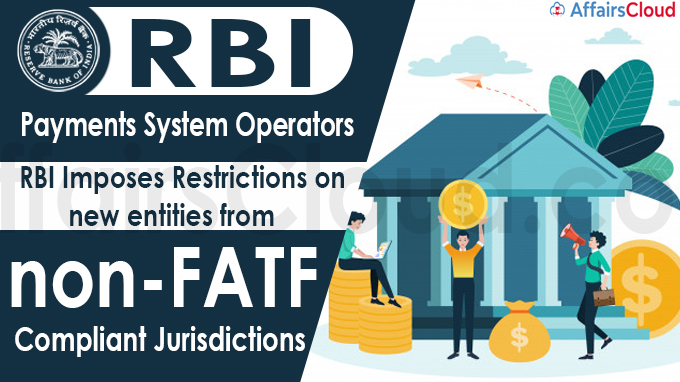 On June 14, 2021, under Section 18 read with Section 10(2) of the Payment and Settlement Systems Act, 2007, the Reserve Bank of India (RBI) issued regulations for investments in Payment Systems Operators (PSOs) by new entities from Financial Action Task Force (FATF) Non-compliant Jurisdictions (Countries).
On June 14, 2021, under Section 18 read with Section 10(2) of the Payment and Settlement Systems Act, 2007, the Reserve Bank of India (RBI) issued regulations for investments in Payment Systems Operators (PSOs) by new entities from Financial Action Task Force (FATF) Non-compliant Jurisdictions (Countries).
Restrictions imposed by RBI:
i.New Investors:
- RBI has not permitted new investors from or through non-compliant FATF jurisdictions to acquire, directly or indirectly, ‘significant influence’ in PSOs (existing PSOs/ entities seeking authorisation as PSOs).
- Fresh investments (directly or indirectly) from those non-compliant FATF jurisdictions, in aggregate, should account for less than 20 percent of the voting power (including potential voting power) of the PSO.
ii.Existing Investors:
- Investors holding their investments in PSOs (existing) before the classification of the source or intermediate jurisdictions as FATF non-compliant are allowed to continue with the investments by RBI (Their additional investments should be as per the current regulations).
Note – As per the restriction placed by RBI investments in PSOs from FATF non-compliant jurisdictions shall not be treated at par with that from FATF compliant jurisdictions.
About FATF Non-Compliant Jurisdictions:
i.FATF used to identify jurisdictions with weak measures to combat money laundering and terrorist financing under its publications of – High-Risk Jurisdictions subject to a Call for Action, and Jurisdictions under Increased Monitoring.
- A jurisdiction whose name appears in these two lists is referred to as a FATF Non- compliant jurisdiction and the jurisdiction that doesn’t appear in both categories are the FATF compliant Jurisdictions.
– RBI has released the Consultative Document on Regulation of Microfinance
RBI has released the Consultative Document on Regulation of Microfinance for feedback from all stakeholders.
Objective: To address the over-indebtedness of microfinance borrowers and enable a market mechanism to bring down interest rates by empowering the borrowers to make an informed decision.
Key Proposals of the Document:
i.It suggests a common definition of microfinance loans that is uniformly applicable to all regulated entities to ensure certainty, irrespective of the type of lenders.
ii.RBI suggested displaying minimum, maximum and average interest rates charged on microfinance loans on the website of the regulated entities (for borrowers).
iii.Pricing of Loans:
- The new framework introduced a standard simplified fact sheet on the pricing of microfinance loans for better transparency and to provide freedom of pricing.
Existing Rules of pricing:
- Non-Banking Financial Companies – Microfinance Institutions (NBFC-MFIs) are permitted to charge only three components viz., interest charge, processing fees (limit of 1 percent of the gross loan amount) and insurance premium on an actual basis.
- Interest rate: Currently, the interest rates are based on the cost of funds plus the margin of 10 percent for NBFC-MFIs with loan portfolio exceeding Rs 100 crore and 12 percent for others; 2.75 times the average base rate of the five largest commercial banks.
- Note – These pricing restrictions were introduced in 2014 as per the recommendations by a YH Malegam committee.
iv.Suggested capping of repayment of loan interest principal outstanding loans of the household to 50 percent of the household income.
v.The current limit of lending by not more than two NBFC-MFIs to the same borrower was removed.
vi.Suggested a Board approved policy for household income assessment and neglected the prepayment penalty; requirement of collateral; and added greater flexibility of repayment frequency for all microfinance loans.
Recent Related News:
The 17 jurisdictions flagged by the FATF under its publications of” High-risk jurisdictions subject to a Call for Action “, and “jurisdictions under Increased Monitoring” are restricted by RBI on the fresh investments in India’s Non-Banking Finance Companies (NBFCs).
On April 7, 2021, RBI extended the classified lending of Banks to NBFCs for on-lending under the Priority Sector Lending (PSL) for 6 months i.e. up to September 30, 2021.
About Financial Action Task Force (FATF):
FATF is an inter-governmental body that sets standards and develops and promotes policies to combat money laundering and terrorist financing. India became a member of the FATF in 2010.
Establishment – 1989 by the G-7 Summit.
Headquarters – Paris, France
President – Marcus Pleyer (Germany)
Member countries – 39
About Non-Banking Financial Company: Micro Finance Institution (NBFC-MFI):
NBFC-MFI is defined as a non-deposit taking NBFC (other than a company licensed under Section 25 of the Indian Companies Act, 1956) that fulfils the following conditions:
i.Minimum Net Owned Funds of Rs 5 crore. (For NBFC-MFIs registered in the country’s North Eastern Region, Rs. 2 crore).
ii.It should have 85 percent of its net assets in the nature of ‘qualifying assets’.




